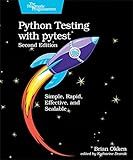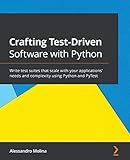Best Pytest Automation Tools to Buy in December 2025
To run a script as a pytest test, you can create a test file where you import the script you want to test and write test functions that call the functions in your script. You can then use the pytest command in the terminal to run the test file and see the results. Make sure to install pytest using pip before running the tests. Additionally, you can use pytest fixtures to set up the environment for your tests and run specific tests using the -k flag followed by the name of the test function you want to run.
How to run a script as pytest test?
To run a script as a pytest test, you need to follow these steps:
- Install pytest: Make sure you have pytest installed in your Python environment. You can install pytest using pip by running the following command:
pip install pytest
- Create a test script: Create a new Python script or modify an existing script to include test functions that use pytest assert statements to make assertions about the code’s behavior.
- Use pytest conventions: To make sure the script is recognized as a pytest test, use the following conventions:
- Test function names should start with "test_"
- Use pytest assert statements to perform assertions
- Place the test script in a directory with a name that includes "test" or "tests"
- Run pytest: Open a terminal or command prompt and navigate to the directory containing your test script. Run the following command to execute the script as a pytest test:
pytest <test_script_name>.py
Replace <test_script_name>.py with the name of your test script.
- View test results: pytest will run the test script and display the test results in the terminal or command prompt. You will see information about passed, failed, or skipped tests along with any error messages.
By following these steps, you can run a script as a pytest test and easily test the functionality of your Python code.
What is the correct way to run pytest tests in a CI/CD pipeline?
To run pytest tests in a CI/CD pipeline, you can follow these steps:
- Install pytest in your project by adding it to your requirements.txt file or using pip install pytest.
- Create a script or command in your CI/CD pipeline configuration file (e.g. .gitlab-ci.yml or Jenkinsfile) to run pytest. For example, you can add a command like pytest tests/ to execute all test files in the tests directory.
- Make sure your CI/CD environment has the necessary dependencies installed to run pytest and your tests. This may include setting up virtual environments, installing dependencies from requirements.txt, and configuring any necessary environment variables.
- Configure your pipeline to run pytest on every push to the repository or on specific triggers (e.g. pull requests, merge requests).
- Make sure to include proper reporting and handling of test failures in your pipeline configuration, such as failing the build if any tests fail or triggering notifications to relevant team members.
- Review the test results and any logs generated by pytest to identify any issues or failures that need to be addressed.
By following these steps, you can ensure that your pytest tests are effectively integrated into your CI/CD pipeline and run automatically to validate the code changes made to your project.
How to run multiple test cases using pytest?
To run multiple test cases using pytest, you can create test functions or classes containing individual test cases and then use the pytest framework to execute them. Here's a step-by-step guide on how to run multiple test cases using pytest:
- Create individual test functions or classes with test methods that represent different test cases. For example:
# test_example.py
def test_case1(): assert 1 + 2 == 3
def test_case2(): assert 3 * 4 == 12
- Save the test functions or classes in a separate Python file (e.g., test_example.py).
- Open a terminal or command prompt and navigate to the directory where your test file is located.
- Run the following command to execute all test cases in the test file using pytest:
pytest test_example.py
- You should see the output of pytest indicating the status of each test case - whether they passed or failed.
You can also organize your test functions and classes into different modules or packages and run all tests in a directory or recursively search for tests using pytest. Check out the argparse and plugin options in pytest documentation for more advanced usage.




